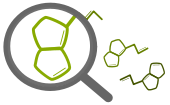Welcome to the Clean Energy Project Database: an Information Hub for Organic Electronics
The Clean Energy Project Database (CEPDB) is a massive reference database for organic semiconductors with a particular emphasis on photovoltaic applications. It was created to store and provide access to data from computational as well as experimental studies, on both known and virtual compounds. It is a free and open resource designed to support researchers in the field of organic electronics in their scientific pursuits.
The CEPDB was established as part of the Harvard Clean Energy Project (CEP), a virtual high-throughput screening initiative to identify promising new candidates for the next generation of carbon-based solar cell materials. It is maintained by the Aspuru-Guzik Research Group in the Department of Chemistry and Chemical Biology at Harvard University and supported by a number of external partners. The bulk of the computational data was generated in collaboration with IBMâs World Community Grid, a virtual supercomputer that harnesses surplus computing power donated by hundreds of thousands of volunteers around the world.
The CEPDB contains data on 2.3 million molecular motifs, derived from 150 million density functional theory calculations. To our knowledge, this represents the most extensive quantum chemical investigation ever conducted. The studied compounds are part of a virtual screening library, which was combinatorially generated from a set of experimentally motivated building blocks. The compiled data of this large-scale investigation, as well as that from other studies, is now made available to the community in the form of this public information repository.

